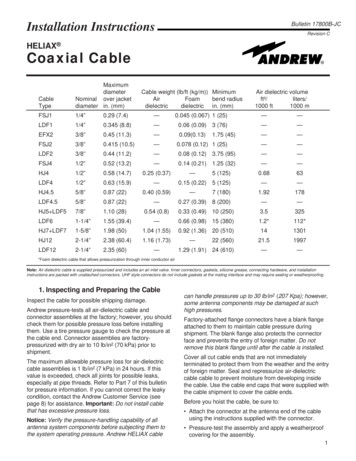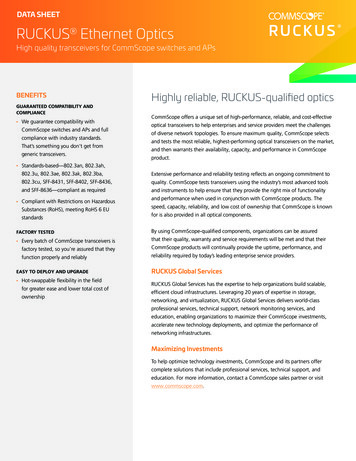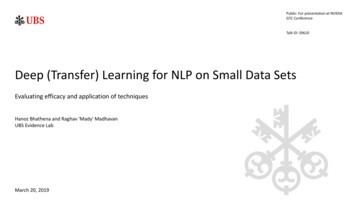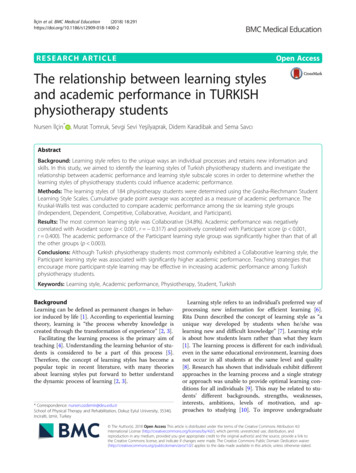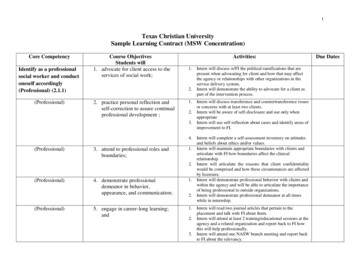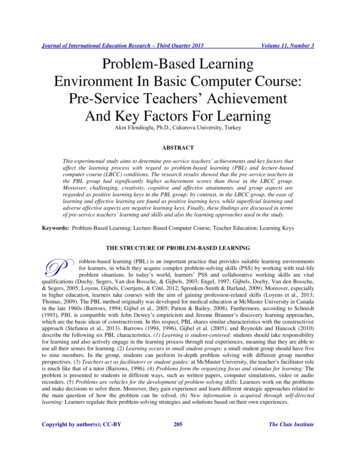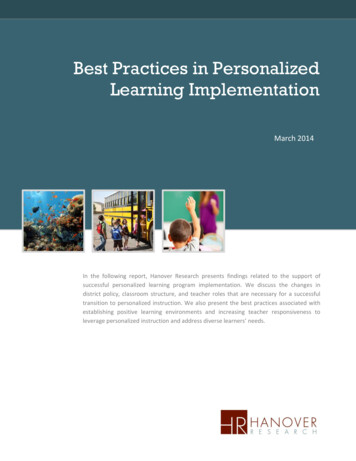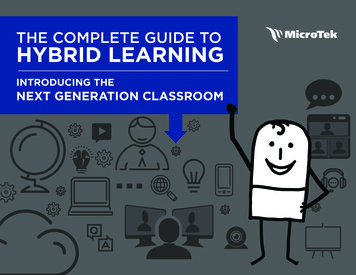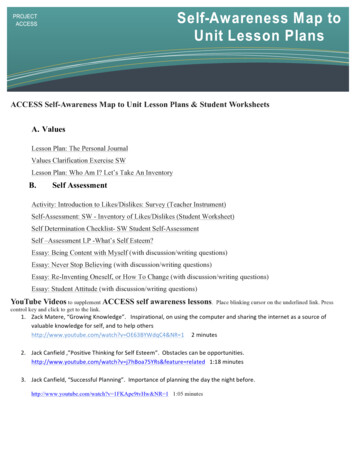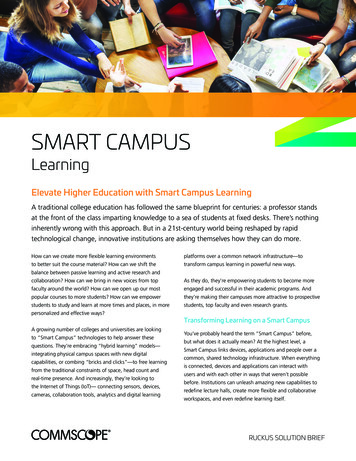
Transcription
SMART CAMPUSLearningElevate Higher Education with Smart Campus LearningA traditional college education has followed the same blueprint for centuries: a professor standsat the front of the class imparting knowledge to a sea of students at fixed desks. There’s nothinginherently wrong with this approach. But in a 21st-century world being reshaped by rapidtechnological change, innovative institutions are asking themselves how they can do more.How can we create more flexible learning environmentsplatforms over a common network infrastructure—toto better suit the course material? How can we shift thetransform campus learning in powerful new ways.balance between passive learning and active research andcollaboration? How can we bring in new voices from topAs they do, they’re empowering students to become morefaculty around the world? How can we open up our mostengaged and successful in their academic programs. Andpopular courses to more students? How can we empowerthey’re making their campuses more attractive to prospectivestudents to study and learn at more times and places, in morestudents, top faculty and even research grants.personalized and effective ways?A growing number of colleges and universities are lookingto “Smart Campus” technologies to help answer thesequestions. They’re embracing “hybrid learning” models—integrating physical campus spaces with new digitalcapabilities, or combing “bricks and clicks”—to free learningfrom the traditional constraints of space, head count andreal-time presence. And increasingly, they’re looking tothe Internet of Things (IoT)— connecting sensors, devices,cameras, collaboration tools, analytics and digital learningTransforming Learning on a Smart CampusYou’ve probably heard the term “Smart Campus” before,but what does it actually mean? At the highest level, aSmart Campus links devices, applications and people over acommon, shared technology infrastructure. When everythingis connected, devices and applications can interact withusers and with each other in ways that weren’t possiblebefore. Institutions can unleash amazing new capabilities toredefine lecture halls, create more flexible and collaborativeworkspaces, and even redefine learning itself.RUCKUS SOLUTION BRIEF
Flexible Learning SpacesOn a Smart Campus, mobile technologies and applications free educators to rethink how they deliver learning. They can repurposeclass spaces to fit the lessons—having everyone sit in a circle for a demonstration one minute and breaking up into collaborativeworkgroups the next. Students and faculty can share or cast the screens of their personal devices easily—without worrying aboutnetwork or power cabling.Why stick to traditional lecture hall configurations when you can reconfigure any room on the fly, without losing connectivity todigital tools and curricula? Why stay inside at all when you can move the lecture outdoors? Professors can still lead guided learningfor their classes. But now, students can participate from their dorm room, the library, or sitting under a tree out in the quad.New Learning ModelsSmart Campus technologies can change the way students learn. When every student has nonstopaccess to audio and video conferencing tools, they can jump on a collaborative working session inseconds. With access to capabilities like screen casting and file- and application-sharing from theirpersonal devices (such as with Google Docs, Office 365, Box, etc.), multiple students can workcollaboratively on the same project without having to be in the same physical place.Digital PortalsMost colleges and universities are already embracing digital learning management systems (LMS)like Blackboard and Instructure. A Smart Campus provides ubiquitous, rock-solid wired and wirelesscoverage everywhere, so students can easily access these portals anytime, from any personal device.Grades, assignments, submitting homework, even online assessments—everything is at students’fingertips, whether they’re in studying in the residence hall or enjoying the sunshine on the quad.Virtual LabsStudents studying modern science, engineering, and computer science disciplines need access toheavyweight computational resources. In the past, that meant reserving dedicated time in a lab fora project. On a Smart Campus, that lab doesn’t have to be a fixed location. Instead, colleges canvirtually spin up cloud resources and deliver them to students wherever they’re needed—and spinthem back down again when they’re no longer in use. And spaces currently reserved for dedicatedcomputing resources can repurposed for something else.Distance LearningOn a Smart Campus, students, faculty and administrators no longer need to worry about spaceconstraints, location or weather. Use video and collaboration tools to open up classes and lectures tomore students, without having to squeeze them all into a single lecture hall. When students are ill,when bad weather makes it difficult to get to campus, class can still go on. Students can log into livelectures from their PCs, participate in discussions, download course materials and submit assignmentswithout missing a beat.For universities themselves, distance learning offers even more possibilities. Grow the institution’sreputation (and enrollment) by opening up courses to online attendees through massive open onlinecourses (MOOCs). Expand your reach to students who aren’t in a full-time degree program—and givethem a taste of the experience you can provide if they enroll on campus. Make life easier for studentswith physical disabilities who struggle to get to some classes. Expand the roster of superstar lecturersby conferencing in experts in their field from across campus or around the world.2RUCKUS SOLUTION BRIEF Smart Campus - Learning
Lecture CaptureIn the same way that Smart Campus technologies free students and faculty from the constraints ofphysical space, they also afford more flexibility and freedom in time. By recording and archiving alllectures, when an ill student misses class—or just wants to review before a test—every second ofevery lecture can be streamed with a click of a mouse.Library of the FutureWhen students can research and work productively from anywhere, libraries can be reimagined asmultipurpose media centers. The library can still be a place for dedicated research. But now, withconference rooms, quiet rooms, reconfigurable workspaces—even dedicated “maker” spaces—thelibrary becomes a vibrant hub for working collaboratively and engaging with campus life.A Smart Campus makes all of this possible. And it uses a robust, highly reliable wired and wireless infrastructure in libraries andmedia centers that can deliver nonstop connectivity to every user, even as the number of users and devices grows much denserthan in the past.Bringing Campus Data to the CurriculumAll of these Smart Campus experiences can make learning more dynamic, flexible and effective for students and faculty. And all ofthem are possible right now. As colleges and universities look to the near future, however, and begin to view their digital learningtechnology infrastructure as a platform for IoT applications, there’s another major element of a Smart Campus that can directlyimpact learning: analytics.When colleges connect sensors, building systems and other devices (once again, over the same common infrastructure that enablesdigital learning models and flexible workspaces), they can begin to collect data from a variety of sources across the campus.Air QualityTraffic FlowWatering UseParking Availibility3RUCKUS SOLUTION BRIEF Smart Campus - LearningLighting Use
All of that data can be used by campus operations teams to pursue the common goals of IoT implementations: reducing energyconsumption and power costs, refining services on campus to make them more convenient and effective, and more. However,those data and analytics can also be funneled directly to the classroom.Students in a variety of courses—public policy, statistics, environmental studies, psychology, mathematics, computer science—nowhave a wealth of real-world data, drawn from their own campus environment, to study and apply to their projects. All of a sudden,course work that used to be conducted largely in the abstract has concrete, real-world implications for students’ own lives andcommunities.REIMAGINING CAMPUS LEARNINGFor students and faculty, these kinds of Smart Campus learning applications elevate the academic experience in powerfulways. Students can learn (and professors can teach) in the way that’s most effective for them. Faculty can more easilytake advantage of the world of information and expertise at their students’ fingertips, and help them discover newvoices and insights that they never had access to before. Students in a variety of subjects can use data from their ownlives and environments to make their course work more relevant, interesting and engaging. And, with ubiquitousmobility and connectivity, students can more easily integrate study and collaborative work into their lives, and reinvesttime that otherwise might have been wasted.At the same time, colleges can use their digital infrastructure to deliver other applications and services that elevate life on campus.Once an institution has linked devices, sensors, applications and analytics over a common infrastructure, they can:·· Enable new Smart Campus lifestyle experiences like wayfinding and location-based services, smart transit and parking, connectedlighting and building control systems, and more·· Make the campus safer and more secure with connected surveillance cameras, smart locks and perimeter controls, asset trackingand smart emergency services·· Lower costs by using intelligent electricity, water and building controls to reduce power and water consumption·· Create a greener campus by linking sensors and campus infrastructure systems to conserve electricity and reduce carbonfootprintAll of these applications are possible on a Smart Campus—and all of them run on the same common, campus-wide digitalinfrastructure. (For the full story, see the eBook: Building a Smart Campus: The Journey Starts Here: smartcampus-ebook4RUCKUS SOLUTION BRIEF Smart Campus - Learning
Trust CommScope on Your Smart Campus JourneyCommScope has been a leader in connecting higher education institutions for many years. Around the globe, college anduniversity IT departments trust CommScope to help them deliver lightning-fast, reliable wireless and wired connectivity everywhereon campus. Now, we’re helping higher education leaders build new smart solutions to elevate the academic experience andtransform life on their campuses.We combine industry-leading Wi-Fi innovations with state-of-the-art wired infrastructure and cloud management solutions,advanced analytics, and location-based services that use the campus network to bring intelligence and decision-making closer tousers and devices.Ruckus PortfolioCloudpathSmartZoneSCI— Hassle-free, self serviceon-boarding & pre-boarding— Easily set up, manage, andtroubleshoot the network— Glean actionable insights fromthousands of devices— Personal networks— Campus-level view of theentire infrastructure— Machine learning networkintelligence— Manage policy for all devicesAccess PointsICX Switches— Wall-mount AP/switch forresidence halls & IPTV— Industry’s bestperformance/value— Industry’s best outdoor APs— Easy-to-managecampus fabric— The best connection toevery deviceSPoT— Track assets— Target services & information— Event managementAll of these Ruckus solutions use open APIs, allowing you to easily integrate with devices, applications and management solutionsfrom multiple vendors—or even new solutions created on your own campus. And they’re backed by a broad ecosystem of industryleading IoT partners that deliver ready-to-deploy solutions for advanced analytics, smart lighting, video surveillance, buildingautomation and many other Smart Campus use cases.5RUCKUS SOLUTION BRIEF Smart Campus - Learning
Get StartedThe competition in higher education—for students, top faculty, even research grants—will continue to heat up. To succeed,colleges and universities will need to find new ways to engage students in the academic curriculum, expand enrollment and standout from the crowd. New hybrid learning models, ubiquitous connectivity and collaboration, IoT analytics and other Smart Campusapplications can provide powerful capabilities to help them make it happen.Ready to start your Smart Campus journey? Contact your local CommScope account representativeor visit ruckuswireless.com/contactSee our Smart Campus solution ommScope pushes the boundaries of communications technology with game-changing ideasand ground-breaking discoveries that spark profound human achievement. We collaborate withour customers and partners to design, create and build the world’s most advanced networks. Itis our passion and commitment to identify the next opportunity and realize a better tomorrow.Discover more at commscope.comcommscope.comVisit our website or contact your local CommScope representative for more information. 2019 CommScope, Inc. All rights reserved.All trademarks identified by or are registered trademarks or trademarks, respectively, of CommScope, Inc. This document is for planning purposes only and is not intended to modify orsupplement any specifications or warranties relating to CommScope products or services. CommScope is committed to the highest standards of business integrity and environmentalsustainability with a number of CommScope’s facilities across the globe certified in accordance with international standards, including ISO 9001, TL 9000, and ISO 14001.Further information regarding CommScope’s commitment can be found at y-and-Sustainability.CO-113897-EN (11/19)
Transforming Learning on a Smart Campus . New Learning Models Smart Campus technologies can change the way students learn. When every student has nonstop . (For the full story, see the eBook: Building a Smart Campus: The Journey Starts Here: smartcampus-ebook 4 RUCKUS SOLUTION BRIEF Smart Campus
